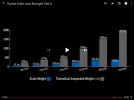Sorry Pinnah, but I respectfully disagree...
It's simple geometry, really. The pivot pin is ahead of the lock bar. Any forced pressure on the cutting edge wouldn't raise the lock bar if the pivot was sloppy, it would do exactly the opposite and the lock bar would fall below the bolster, not rise above it.
Additionally; the blade stops rotating when it meets the lock-bar. At the same time, the lock bar engages the notch in the blade.
Really, there's not a whole lot that can go wrong with this design. If you have a 110 that is experiencing this, it should be repaired or replaced.
I've used and abused dozens of different 110s and have had dozens of them apart. From some of the oldest to some of the newest, I've not witnessed enough erosion of the parts on any of them to cause a serious failure.
I'm going out on a limb and guessing that 100% of the blades are harder than 100% of the lock bars. When that's the case, the blade could (and should) wear the face and locking tab on the lock-bar. Is this erosion enough to measure and effect the locking mechanism? Perhaps on a knife that is opened and closed a lot, but for these parts to deform from hard use; I ain't buyin' it.
View attachment 908082
MT_Pokt,
Thanks for posting the picture of the 110 internals, as that perfectly shows what I was describing.
Before I clarify, note that I own more lockbacks than any other style of knife - most of them Bucks. My assumption is that the phenomenon of lock rock is pretty well understood by most lockback enthusiasts. It's an issue that's been raised by many (other than me) on this and other forums. IMO, lockbacks make great hunting knives and make great EDC knives. I carry a 110 when I hunt and my 500 is in my regular EDC rotation. As with rifles and cars, no one design does all things. The lockback regularly wins tests on resisting strong closing forces and nothing I'm saying challenges any of that.
Note the interface between the blade tang notch and the front face of the lockbar up by the top red arrow and notice that is angled something like a "\" character. And now compare that to the same interface on any traditional slip joint like, say, the Buck 307 I'm carrying today, or perhaps a Sodbuster. You will see that on a slip joint, the angle vertical, like a "|" character.
If you slowly close a lockback like the aluminum bolstered 110 I have with me and compare it to how a slip joint closes, you can see why the lockback has a \ angle while a slip joint can use a |. On a slip joint, the cam shape to the blade's tang lowers the spring early, allowing the spring (bar) to be aligned with the stop face on the blade tang when they meet. In contrast, the lock bar on a lockback stays high as the hook of the lock bar rides over the rounded face of the tang and it doesn't drop into the notch until the very last. The \ angle allows that last drop to happen without hang up.
However, under hard cutting pressure the \ angle of the lockback will act like a wedge and that will cause the front of the lock bar to be lifted upwards relative to the spine of the blade. Generally speaking, slip joints don't develop vertical play unless they are very badly damaged. Also notice that if the lockbar is lifted high enough, the locking notches will no longer be aligned enough to catch. It is exactly as if the lock bar has been opened because it has.
In terms of wear, my experience is that lockbacks that develop lock rock continue to loosen up with use. As with many mechanical things, slop allows more slop to develop. Like many folks here, I've returned knives to Buck and yes, Buck is incredible with their warranty, but they've told me directly that the metal framed traditional lockbacks tend to hold up better compared to their plastic handled ones and that has certainly been my experience. My understanding (and by all means, Jeff Hubbard can correct me if I'm not understanding things right) is that having tight pivots for the blade and lock bar are critical.
In terms of the wear of fine blanked steels when used for lockbacks, I noted that that point was made by Sal Glassner of Spyderco in another BladeForums forum back before the conversion. Perhaps good search could dig it up again.
My only point was a small one and I don't think at all controversial. Lock strength is not just about resisting closing. It also involves being able to resist damage from strong cutting forces.
I've never owned a Cold Steel and have not plans to, but their Triad lock design seems to be a real honest evolutionary advancement on the lock back design that Buck popularized. Perhaps someday the patent will run out and Buck will incorporate it.



